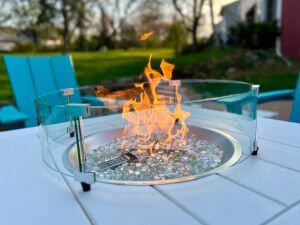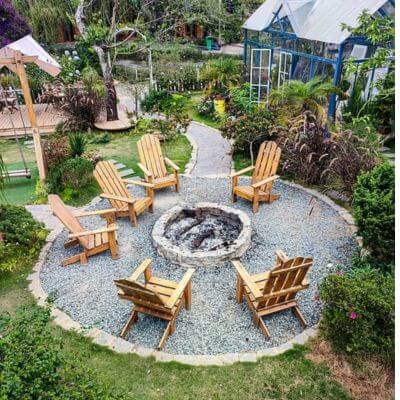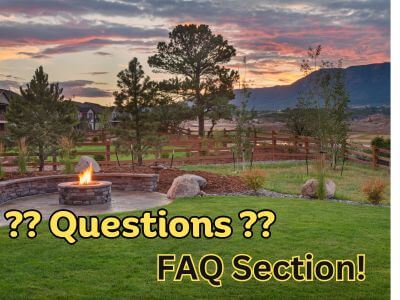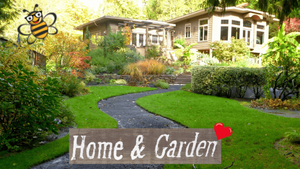In a world where backyard fire pits have become increasingly popular, it's crucial for homeowners to prioritize safety. In this article, we delve into fire pit safety for homeowners and renters to follow.
Welcome to our article! Bertie here exploring the importance of fire pit safety precautions for you! We aim to educate our readers on the potential risks involved.

When it comes to fire pits, understanding the various construction types is vital for safe usage.
From traditional wood-burning to propane-fueled options, here is an in-depth analysis of each type's features and an outline of the necessary safety measures associated with them.
These safety measures go for a portable fire pit as well as permanent one.
Traditional Wood-Burning:

Traditional wood-burning fire pits offer a classic and authentic outdoor fire experience.
They typically consist of a steel or stone bowl or square where you can burn logs or firewood. Wood-burning fires are known for their crackling sounds, mesmerizing flames, and the aroma of burning wood.
Wood burners are relatively affordable and can add rustic charm to your outdoor space.
Safety Measures:
- Choose an open, well-ventilated area away from flammable materials,
structures, and overhanging branches. You don't want anything nearby to
accidentally catch fire!
- Keep a fire extinguisher, hose, or bucket of water nearby for quick extinguishing.
- Use a fire screen to contain embers and sparks.
- Never use accelerants like gasoline to start the fire.
- Supervise children and pets closely around the fire.
- Fully extinguish the fire before leaving the area.
Propane-Fueled:

Propane fueled are convenient and easy to use, making them a popular choice for those seeking a hassle-free outdoor fire experience.
They feature a burner connected to a propane tank, allowing you to control the flame's intensity with a knob or switch.
Propane fire pits are versatile, as they often come in various designs, including fire tables, fire bowls, and more modern options.
Safety Measures:
- Follow the manufacturer's instructions for propane tank setup and connection.
- Check for gas leaks using a soapy water solution before lighting the fire.
- Store propane tanks in a well-ventilated area away from direct sunlight and
heat sources.
- Keep the propane tank's valve and regulator in good condition.
- Do not store or use propane tanks indoors.
- Use a spark screen or safety cover when the fire pit is in use.
- Turn off the propane supply when not using the fire pit.
Natural Gas:
Natural gas fueled are similar to propane fire pits but are connected to your home's natural gas line, providing a continuous and cost-effective fuel source.
They offer convenience and ease of use without the need to refill tanks. Natural gas fire pits can be built-in or portable, allowing you to customize your outdoor space.
Safety Measures:
- Ensure proper installation by a licensed professional to connect the fire pit to
your natural gas line.
- Regularly inspect gas lines and connections for leaks or damage.
- Keep the gas shut-off valve accessible and in good working condition to
avoid toxic fumes.
- Use a spark screen or safety cover so something nearby won't catch fire by a
burning ember blown by a breeze.
- Do not enclose or cover the natural gas fire pit during use, as this can create a
hazardous buildup of gas.
- Never modify the natural gas system or attempt to connect it yourself.
Gel-Fueled:

Gel-fueled use alcohol-based gel fuel canisters to create a controlled flame. They are known for their portability and suitability for smaller outdoor spaces or even indoor use. Gel-fueled fire pits come in various designs, including tabletop models and fire bowls.
Safety Measures:
- Only use manufacturer-recommended gel fuel canisters.
- Keep extra canisters in a cool, well-ventilated area away from open flames or
heat sources.
- Do not refill gel fuel canisters.
- Supervise children and pets when the fire pit is in use.
- Use a snuffer tool to extinguish the flame, as gel fuel canisters cannot be easily
extinguished by blowing them out.
- Ensure proper ventilation when using gel-fueled fire pits indoors.

By understanding the construction types and following the associated safety measures for each type of fire pit, you can enjoy the beauty and warmth of outdoor fires while minimizing risks and ensuring a safe and enjoyable experience for you, your family, and your guests.
Always prioritize safety and adhere to manufacturer guidelines for the specific fire pit you choose.
There are many types of these wonderful backyard additions available. We explore the variations, including built-in fire pits, portable fire pits, and chimineas in our article "How To Choose the Right Fire Pit for Your Backyard!" Plus we have articles about the best round fire pits as well as square pits and even tabletops!
Top Safety Tips From the Experts!
We have conducted comprehensive research with fire safety experts to identify the top safety tips for fire pit usage.
1. Select the Right Location:
Choosing the right location for your outdoor fire pit is paramount to ensure safety from accidental backyard fires.
Place it on a non-combustible surface, such as a concrete pad or fire-resistant pavers, to prevent the risk of the fire spreading to nearby vegetation or structures. It's so easy for things to inadvertently catch fire.
Ensure that the location is well-ventilated and free from overhanging branches, awnings, yard waste, or anything that could catch fire. Avoid lighting fires near any flammable objects.
Follow the manufacturer's recommendations for minimum clearance distances and backyard fire safety.
2. Use a Fire Pit Screen:
A fire pit screen or spark guard is a crucial safety accessory for your outdoor fire pit. It helps contain flying sparks, embers, and ashes within the fire pit, reducing the risk of accidental fires and burns.
Make sure your outdoor fire pit comes with a screen, or purchase one separately if needed. Keep the screen in place whenever the fire is burning, and ensure it fits securely to prevent any gaps where sparks could escape.
3. Keep a Fire Extinguisher or Hose Nearby:
Safety always includes being prepared for emergencies. Have a fire extinguisher designed for Class A, B, and C fires within easy reach, and ensure it is in good working condition. (See our article Don't Be Caught Unprepared in a Fire Emergency: Invest in These Top-Rated Home Fire Extinguishers!)
Alternatively, keep a garden hose with a spray nozzle nearby. If a fire starts to get out of control or sparks fly where they shouldn't, you can quickly extinguish the flames or cool down the area.
4. Maintain a Safe Distance:
Situate seating areas and other furniture at a reasonable distance to avoid accidental contact with the flames or hot surfaces. Ensure that children and pets are supervised at all times around the fire pit and that they understand the importance of not getting too close to it.
5. Use the Right Fuel:
Use only approved fuels for your fire pit. For wood-burning, seasoned hardwoods are typically the best choice, as they burn cleanly with minimal smoke and sparks.
Avoid using treated or painted wood, which can release toxic fumes when burned. Do not use chemically treated wood pallets for fuel as they can also emit toxic fumes.
For gas or propane, follow the manufacturer's guidelines for the appropriate fuel sources and never use flammable liquids like gasoline to start the fire.
6. Don't Leave the Fire Unattended:
Never leave a fire pit unattended while it's burning. Even a small flame can quickly escalate into a dangerous situation if left unchecked. Many backyard fires can be prevented by this simple safety precaution.
Before leaving the fire pit area, put out the fire completely. For ultimate backyard fire safety, use a poker or fire tongs to spread the embers and ashes, and pour water over them until they are cool to the touch.
Be doubly sure to quench the fire completely!
7. Be Mindful of Wind Conditions:
Wind can significantly affect the behavior of an outdoor fire, spreading sparks and burning embers unpredictably possibly creating out-of-control backyard fires.
Check your weather forecast and the wind conditions before lighting your fire pit and consider using a windbreak or fire screen to mitigate the impact of gusty winds.
Always position yourself upwind from the fire to avoid smoke and sparks blowing in your direction.
8. Dress Appropriately:
When sitting around an outdoor fire pit, dress in appropriate clothing. Avoid loose-fitting or flammable fabrics, and wear long sleeves and pants to protect your skin from sparks. It's a very serious thing if clothes catch fire!
Additionally, consider using fire-resistant gloves when adding wood or making adjustments to the fire.
By following these fire safety tips, you can enjoy the warmth and ambiance of your backyard fire pit while minimizing the risk of accidents and ensuring a safe and enjoyable experience for everyone.
9.Use a Fire Pit Pad:
Using a fire pit pad with portable fire pits on a patio significantly enhances safety, acting as a protective barrier that prevents heat damage and reduces the risk of the surrounding area catching fire. This essential accessory ensures your patio gatherings are both enjoyable and secure.
Accidents Will Happen!
By delving into 3 incidents where fire safety was compromised, we highlight the importance of adhering to proper safety protocols.
--Example 1: The Importance of Proper Extinguishing
Lesson Learned: Properly extinguish an outdoor fire to prevent accidents.
In a suburban backyard, a family was enjoying a cozy evening around their wood-burning fire pit. When they decided to call it a night, they assumed that the fire had burned down completely and left the area.
Unbeknownst to them, a small ember remained, hidden beneath the ashes. As they headed inside, the ember slowly smoldered and reignited the fire, eventually leading to a dangerous situation.
Lesson: This incident emphasizes the importance of fully extinguishing a fire before leaving the area. Even when the flames have died down, embers and hot coals can remain for hours.
Use a poker or fire tongs to spread the embers and ashes, and pour water over them until they are cool to the touch. Ensuring the fire is completely out can prevent accidents, like wildfires or burns, from occurring.
--Example 2: Combustible Materials Nearby
Lesson Learned: Maintain a safe distance from flammable materials.
In a suburban neighborhood, a homeowner had a beautiful wood-burning fire pit on their wooden deck. While enjoying a chilly evening, the homeowner added an extra log to the fire, causing a shower of sparks.
Unfortunately, one of these sparks landed on a pile of leaves nearby, quickly igniting them. Within minutes, the deck was ablaze, and the fire spread to the home, causing extensive damage.
Lesson: This incident underscores the importance of maintaining a safe distance between your outdoor fire pit and flammable materials, especially on wooden surfaces like decks or patios.
For optimal fire safety, clear the area of dry leaves, plants, and other combustible materials before lighting the fire pit. Additionally, consider using fire-resistant mats or protective barriers to create a buffer zone around the fire pit and prevent accidents like this from happening.
--Example 3: Don't Add Fuel to the Flames!
Lesson Learned: Never throw flammable items onto a fire.
Lesson: "The shocking video shows the man stoking the backyard fire with a piece of timber. He then grabs a blue tub, which appears to be full of white fire starters.
He walks over to the fire with the tub before signaling a thumbs up, then a thumbs down to his friends. He throws the contents of the blue tub onto the barbeque, and almost instantly his plan literally backfires."
Fortunately this man wasn't injured. (Source: DailyMail.com.uk)
These real-life examples serve as cautionary tales, highlighting the need for responsible and safe fire pit usage.
They emphasize the importance of following safety guidelines, being diligent about extinguishing fires, and maintaining a fire pit's surroundings to prevent accidents, property damage, and injuries.

How far should a fire pit be placed from flammable materials?
They should be positioned at least 7-10 feet away from any flammable objects or structures to prevent accidents.
Can I use my fire pit on a windy day?
It's a bad idea and is advisable to avoid lighting your backyard fire pit during windy conditions, as strong gusts can cause flames to spread and pose a safety hazard. You may ignite nearby structures. Check your weather forecast for windy conditions!
Is it safe to leave a fire pit unattended?
No, it is crucial never to leave a fire pit unattended. Always ensure the flames are completely extinguished before leaving the area. Never leave a fire unattended!
What should I do if sparks fly out of the fire pit?
Invest in a fire screen or mesh cover before you light a fire to contain sparks and prevent them from reaching flammable objects in the surroundings.
Can I burn trash or other materials in my wood fire pit?
Avoid burning trash, cardboard, paper, plastic, or any materials that can produce toxic fumes or uncontrollable flames.

In conclusion, prioritizing fire pit safety is paramount for every homeowner. By following the essential safety tips provided in this article, individuals can enjoy the warmth and ambiance of their backyard fire pits while minimizing the risk of accidents.
Remember, a few simple precautions can go a long way in ensuring the safety of your home, friends, and family. Stay informed, stay safe.
Thanks for stopping by our bee hive and reading about fire pit safety!

Bertie
Before you leave, if you haven't already done so, please subscribe so you will be the first to see reviews you can rely on.










Member discussion